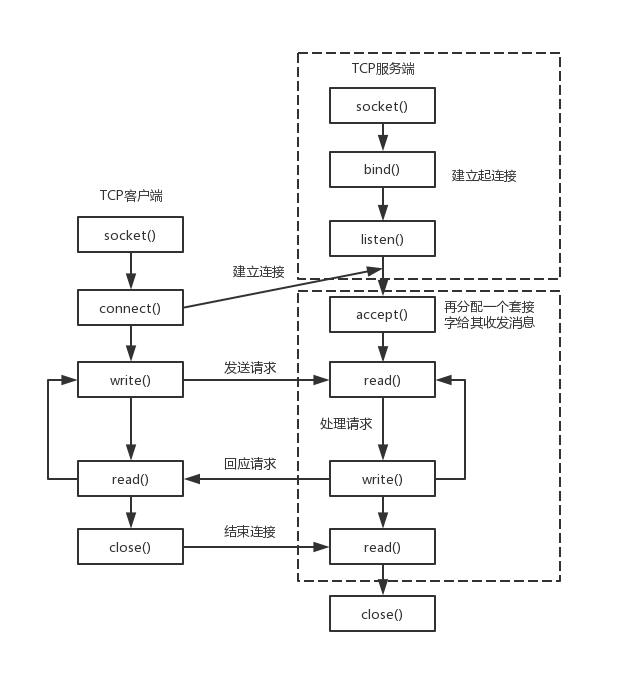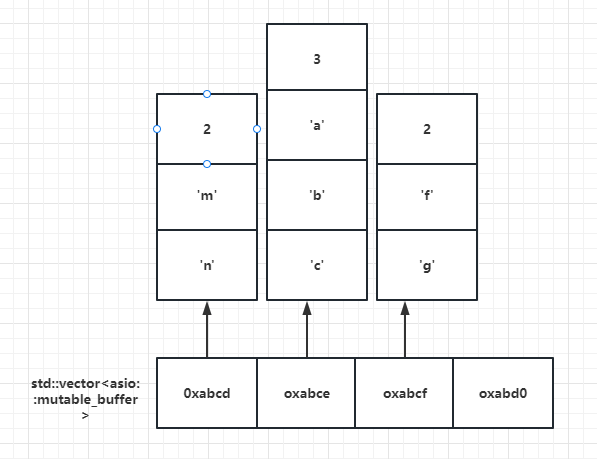网络编程基本流程
网络编程的基本流程对于服务端是这样的
服务端
1)socket—-创建socket对象。
2)bind—-绑定本机ip+port。
3)listen—-监听来电,若在监听到来电,则建立起连接。
4)accept—-再创建一个socket对象给其收发消息。原因是现实中服务端都是面对多个客户端,那么为了区分各个客户端,则每个客户端都需再分配一个socket对象进行收发消息。
5)read、write—-就是收发消息了。
对于客户端是这样的
客户端
1)socket—-创建socket对象。
2)connect—-根据服务端ip+port,发起连接请求。
3)write、read—-建立连接后,就可发收消息了。
图示如下
相关的网络编程技术可以看看我之前写的文章
https://llfc.club/articlepage?id=2LXIKWJtKGblnWtHT7TplLKK6ze
接下来按照上述流程,我们用boost::asio逐步介绍。
终端节点的创建
所谓终端节点就是用来通信的端对端的节点,可以通过ip地址和端口构造,其的节点可以连接这个终端节点做通信.
如果我们是客户端,我们可以通过对端的ip和端口构造一个endpoint,用这个endpoint和其通信。
1 | int client_end_point() { |
如果是服务端,则只需根据本地地址绑定就可以生成endpoint
1 | int server_end_point(){ |
创建socket
创建socket分为4步,创建上下文iocontext,选择协议,生成socket,打开socket。
1 | int create_tcp_socket() { |
上述socket只是通信的socket,如果是服务端,我们还需要生成一个acceptor的socket,用来接收新的连接。
1 | int create_acceptor_socket() { |
绑定acceptor
对于acceptor类型的socket,服务器要将其绑定到指定的断点,所有连接这个端点的连接都可以被接收到。
1 | int bind_acceptor_socket() { |
连接指定的端点
作为客户端可以连接服务器指定的端点进行连接
1 | int connect_to_end() { |
服务器接收连接
当有客户端连接时,服务器需要接收连接
1 | int accept_new_connection(){ |
关于buffer
任何网络库都有提供buffer的数据结构,所谓buffer就是接收和发送数据时缓存数据的结构。
boost::asio提供了asio::mutable_buffer 和 asio::const_buffer这两个结构,他们是一段连续的空间,首字节存储了后续数据的长度。
asio::mutable_buffer用于写服务,asio::const_buffer用于读服务。但是这两个结构都没有被asio的api直接使用。
对于api的buffer参数,asio提出了MutableBufferSequence和ConstBufferSequence概念,他们是由多个asio::mutable_buffer和asio::const_buffer组成的。也就是说boost::asio为了节省空间,将一部分连续的空间组合起来,作为参数交给api使用。
我们可以理解为MutableBufferSequence的数据结构为std::vectorasio::mutable_buffer
结构如下
每隔vector存储的都是mutable_buffer的地址,每个mutable_buffer的第一个字节表示数据的长度,后面跟着数据内容。
这么复杂的结构交给用户使用并不合适,所以asio提出了buffer()函数,该函数接收多种形式的字节流,该函数返回asio::mutable_buffers_1 o或者asio::const_buffers_1结构的对象。
如果传递给buffer()的参数是一个只读类型,则函数返回asio::const_buffers_1 类型对象。
如果传递给buffer()的参数是一个可写类型,则返回asio::mutable_buffers_1 类型对象。
asio::const_buffers_1和asio::mutable_buffers_1是asio::mutable_buffer和asio::const_buffer的适配器,提供了符合MutableBufferSequence和ConstBufferSequence概念的接口,所以他们可以作为boost::asio的api函数的参数使用。
简单概括一下,我们可以用buffer()函数生成我们要用的缓存存储数据。
比如boost的发送接口send要求的参数为ConstBufferSequence类型
1 | template<typename ConstBufferSequence> |
我们需要将”Hello Word转化为该类型”
1 | void use_const_buffer() { |
最终buffers_sequence就是可以传递给发送接口send的类型。但是这太复杂了,可以直接用buffer函数转化为send需要的参数类型
1 | void use_buffer_str() { |
output_buf可以直接传递给该send接口。我们也可以将数组转化为send接受的类型
1 | void use_buffer_array(){ |
对于流式操作,我们可以用streambuf,将输入输出流和streambuf绑定,可以实现流式输入和输出。
1 | void use_stream_buffer() { |